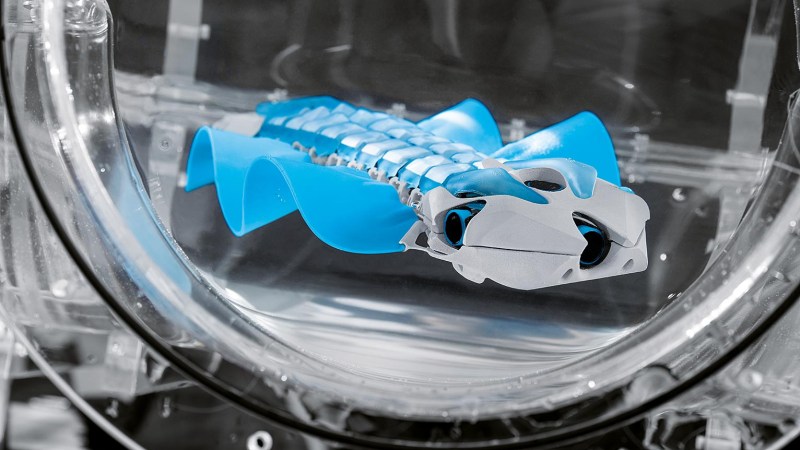[Festo] have come up with yet another amazing robot, a swimming one this time with an elegant propulsion mechanism. They call it the BionicFinWave. Two fins on either side almost a body-length long create a wave which pushes water backward, making the robot move forward. It’s modeled after such fish as the cuttlefish and the Nile perch.
 What was their elegant solution for making the fins undulate? Nine lever arms are attached to each fin. Those lever arms are controlled by two crankshafts which extend from the front of the body to the rear, one for each side. A servo motor then turns each crankshaft. Since the crankshafts are independent, that means each fin operates independently. This allows for turning by having one fin move faster than the other. A third motor in the head flexes the body, causing the robot to swim up or down.
What was their elegant solution for making the fins undulate? Nine lever arms are attached to each fin. Those lever arms are controlled by two crankshafts which extend from the front of the body to the rear, one for each side. A servo motor then turns each crankshaft. Since the crankshafts are independent, that means each fin operates independently. This allows for turning by having one fin move faster than the other. A third motor in the head flexes the body, causing the robot to swim up or down.
There’s also a pressure sensor and an ultrasonic sensor in the head for depth control and avoiding objects and walls. While these allow it to swim autonomously in its acrylic, tubular track, there is wireless communication for recording sensor data. Watch it in the video below as it effortlessly swims around its track.
[Festo] has created a lot of these marvels over the years. We’ve previously covered their bionic hopping kangaroo (we kid you not), their robot ants with circuitry printed on their exoskeleton, and perhaps the most realistic flapping robotic bird ever made.















Holy moly! Neat.
This is SOO KEWL!
Second paragraph, first sentence. s/find/fins/
THIS IS COOL. One of the most natural looking robots I’ve ever seen, especially when it’s moving. That’s a very neat robot!
Festo creatures without the air ray? https://youtu.be/UxPzodKQays
Festo did it again! Amazing guys!
but will it blend?
Hooley dooley! That is awesome :)
Crazy Festo Cuttlefish. WTF? Still can’t figure out if it’s art or engineering, but I know what I like.
I think it pulls off both nicely
Lovecraft meets cyberpunk, i like it
Wow this is great! The motion if the fins really reminds me of an Archimedis’ screw
“It’s modeled after such fish as the cuttlefish and the Nile perch.”
Ummmm… I guess it’s my turn to be pedantic today. The cuttlefish isn’t actually a fish, it’s a mollusk (though it is a good example of this form of locomotion). Also,the Nile perch is a perciform fish (perch like, hence the name) and does not have full body finnage. A knife fish might be a better example for this article.
The first creature that I thought of was a sea slug.
Is it durable? Add a hook and I bet you could catch a lot of fish!
Theo Jansen probably deserves a nod for this design, which seems like an inversion of his Strandbeest sails. Those use an undulating wing to turn a crankshaft.
Looks like something from the Cambrian explosion.
it’s pretty nice and looking good but what about attitude control? also i wonder if this type of catuator is more efficient than a regular propeller in water? and what about cavitation?